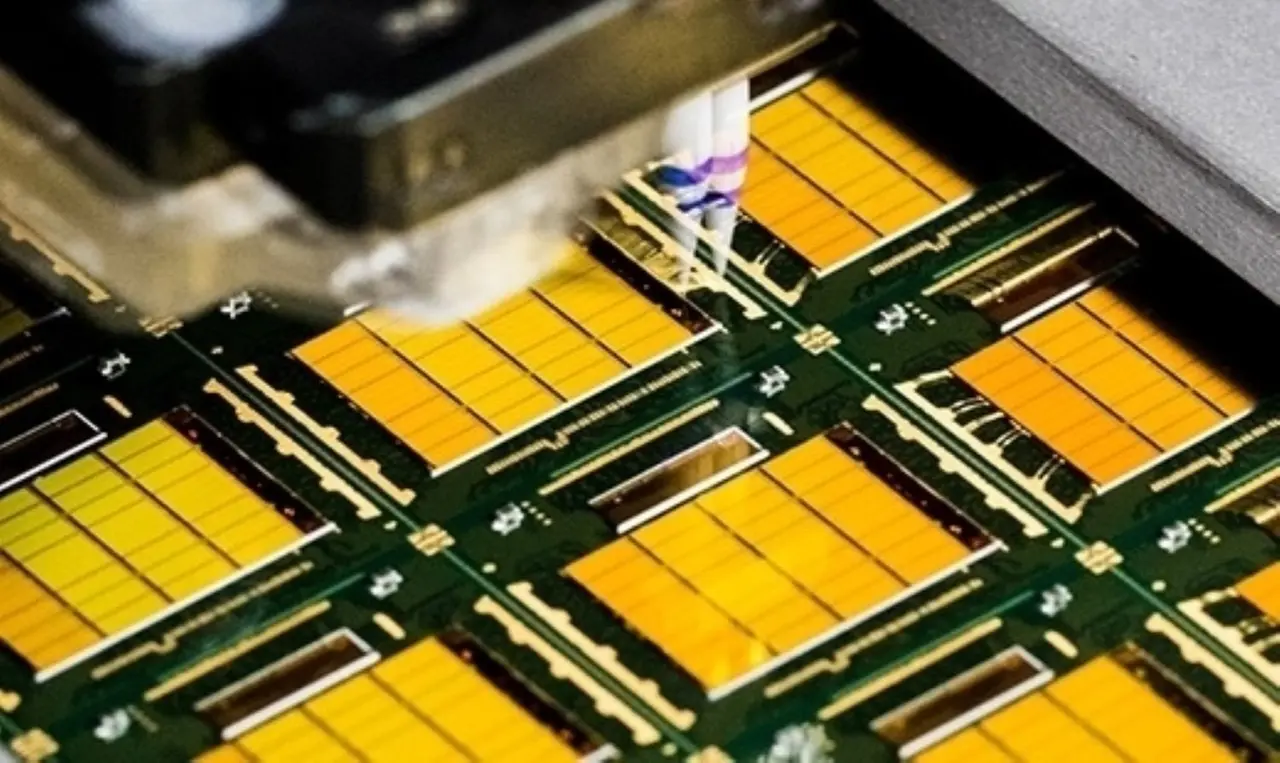Micron Unveils Advanced DDR5 Memory for AI PCs, Boosting Stock Amid Chip Sector Rebound
3 Sources
3 Sources
[1]
What's Going On With Micron Technology Stock Wednesday? - Micron Technology (NASDAQ:MU)
Several stocks in the chip sector are rebounding from weakness on Tuesday. Micron Technology, Inc. MU shares are trading higher on Wednesday as some stocks in the chip sector rebound from Tuesday's drop. The company also unveiled its new clock driver, the DDR5 memory portfolio. What To Know: Micron announced its DDR5 memory portfolio, designed to fuel a new wave of AI PCs. The company introduced two clock driver memory modules capable of delivering speeds of up to 6,400 MT/s (megatransfers per second), more than twice as fast as DDR4. Micron's new portfolio integrates a clock driver directly onto the memory module, ensuring improved speed stability and signal integrity. DDR5 is designed to provide more speed stability, faster downloads and better refresh rates for next-generation PCs. Micron also announced that it validated its DDR5 solutions for use with Intel Corp INTC Core Ultra processors, which were launched on Oct. 10. "As AI takes flight, a memory paradigm shift is needed to keep pace with unprecedented system performance requirements," said Dinesh Bahal, corporate vice president and general manager of Micron's Commercial Products Group. "Micron is shipping the industry's first JEDEC-standard, commercially available DDR5 CUDIMM and CSODIMM solutions to power fast, out-of-the-box speeds for AI PCs and high-end workstations. With this new category, we are arming the ecosystem with next-generation memory solutions to future-proof today's devices for tomorrow's AI workloads." Related Link: Intel, AMD Join Forces To Shape The Future Of Computing What Else: Several chip stocks are recovering from Tuesday's weakness, largely driven by soft guidance out of ASML Holding. The Dutch chip company slashed its full-year sales guidance from a range of 30 billion euros ($32.59 billion) to 40 billion euros to a new range of 30 billion euros to 35 billion euros. In addition, reports surfaced this week that the U.S. is exploring the possibility of curbing chip exports to some countries, which negatively impacted stocks in the chip sector. Currently, the U.S. limits exports of chips to select countries, such as China. However, the new potential controls on chip exports would reportedly focus on Persian Gulf Nations. How To Buy Micron Technology Stock Besides going to a brokerage platform to purchase a share - or fractional share - of stock, you can also gain access to shares either by buying an exchange traded fund (ETF) that holds the stock itself, or by allocating yourself to a strategy in your 401(k) that would seek to acquire shares in a mutual fund or other instrument. For example, in Micron Technology's case, it is in the Information Technology sector. An ETF will likely hold shares in many liquid and large companies that help track that sector, allowing an investor to gain exposure to the trends within that segment. MU Price Action: Micron Technology shares were up 4.14% at $108.65 Wednesday afternoon, according to data from Benzinga Pro. Image: courtesy of Micron Market News and Data brought to you by Benzinga APIs
[2]
Why Micron Rallied Today | The Motley Fool
Micron Technology (MU 4.72%) was caught up in yesterday's semiconductor swoon after ASML Holdings (ASML -6.42%) gave soft guidance for 2025. However, today it appears Micron is bouncing back from those fears, which were likely overblown in Micron's case. Shares of the memory chip leader surged 5% today as of 2:38 p.m. ET. In addition, the company unveiled new DDR-5 products for artificial intelligence (AI) PCs that may have sparked renewed enthusiasm. Yesterday, ASML guided for a softer-than-expected 2025, noting that while AI revenues remain strong, demand for non-AI chips is recovering slower than expected. While lower-than-expected demand may be a headwind for Micron, remember that memory pricing moves around much more than logic chips. So if memory players are moderating their capital spending, that could limit supply and therefore buoy memory pricing. Furthermore, Micron and other memory players have the option of repurposing existing equipment for high-bandwidth memory (HBM) for AI. So even if other end markets are soft, it appears Micron can redirect equipment toward these highly in-demand AI chips. Additionally, today Micron unveiled two new types of DDR-5 memory modules specifically designed for AI personal computers, with clock drivers directly on the memory module, rather than the CPU, as is traditionally the case. Called clocked unbuffered dual inline memory modules (CUDIMM) and clocked small outline dual memory modules (CSODIMM), these new technologies offer speeds that are twice as fast as DDR-4 and 15% faster than traditional DDR-5, and are the first such modified DDR-5 products for AI PCs on the market. Today's release shows that Micron continues to press its technology chops versus peers. Whereas five years ago it was a technology laggard, the company has now caught up with and even surpassed rivals Samsung and SK Hynix in most leading-edge memory technologies. Memory is thought of as a commodity-like industry, but as long as Micron keeps pushing ahead with new technology faster than peers, it should become a more dependably profitable business going forward.
[3]
Micron Unveils DDR5 Memory Boost for AI PCs, Backed by Intel Validation - Micron Technology (NASDAQ:MU)
Intel validated Micron's memory modules for Core Ultra processors, supporting up to 64GB for high-performance systems. On Tuesday, Micron Technology Inc MU announced the release of a new category of clock driver memory modules aimed at next-generation PCs, including AI-driven systems. The company unveiled its Crucial DDR5 clocked unbuffered dual inline memory modules (CUDIMM) and clocked small outline dual memory modules (CSODIMM), now shipping in volume. Based on JEDEC standards, these modules offer speeds up to 6,400 MT/s, over twice the speed of DDR4 and 15% faster than non-clock-driver-based DDR5 solutions. Also Read: Microsoft's AI PCs Stumble With Game Compatibility: Report The newly launched memory modules bring enhanced speed stability, faster downloads, and improved refresh rates, which are crucial for demanding workloads. Intel Corp INTC validated these solutions for its latest Intel Core Ultra processors, so the memory can scale up to 64GB, empowering high-performance PCs and AI workstations. Dinesh Bahal, corporate vice president of Micron's Commercial Products Group, said, "Micron is shipping the industry's first JEDEC-standard DDR5 CUDIMM and CSODIMM solutions to power fast, out-of-the-box speeds for AI PCs and high-end workstations." Dimitrios Ziakas, vice president of memory and I/O technologies at Intel, noted, "The combination of Intel Core Ultra desktop processors and Micron's clock driver-powered memory will propel AI PCs to new heights, delivering 6,400 MT/s speeds." Micron's new offerings are suited for desktop and laptop systems, available from 16GB to 64 GB. According to Canalys, AI PC shipments reached 8.8 million in the second quarter of 2024, accounting for 14% of total PCs. Apple led the AI-capable PC market with its entire Mac lineup, followed by Intel, Advanced Micro Devices, Inc. AMD, and Qualcomm Inc. QCOM. Micron Technology stock gained over 51% in the last 12 months. Cantor Fitzgerald analyst C J Muse cited the upside from Micron's high-margin products and AI-driven data center demand. However, Muse and KeyBanc analyst John Vinh highlighted oversupply concerns as US sanctions on China prompted Samsung to convert its unused HBM capacity back to traditional DRAM to survive the competition. Price Action: MU stock is up 0.70% at $105.05 premarket at last check Wednesday. Also Read: Nvidia and Intel Competition Threaten AMD's Growth, Analyst Says Photo: courtesy of Micron This content was partially produced with the help of AI tools and was reviewed and published by Benzinga editors. Market News and Data brought to you by Benzinga APIs
Share
Share
Copy Link
Micron Technology introduces new DDR5 memory modules designed for AI PCs, receiving validation from Intel. The company's stock rallies as the chip sector recovers from recent setbacks.

Micron's DDR5 Innovation for AI PCs
Micron Technology, Inc. (NASDAQ: MU) has unveiled a groundbreaking DDR5 memory portfolio designed to power the next generation of AI-enabled PCs
1
. The company introduced two new clock driver memory modules, CUDIMM (Clocked Unbuffered Dual Inline Memory Module) and CSODIMM (Clocked Small Outline Dual Memory Module), capable of delivering speeds up to 6,400 MT/s (megatransfers per second)2
. This represents a significant leap, more than doubling the speed of DDR4 and offering a 15% improvement over traditional DDR5 solutions3
.Technical Advancements and Performance Boost
The new memory modules integrate a clock driver directly onto the module, ensuring improved speed stability and signal integrity
1
. This innovation is crucial for handling the demanding workloads of AI-driven systems. Micron's DDR5 solutions have been validated for use with Intel Corp's (NASDAQ: INTC) Core Ultra processors, launched on October 101
3
.Dinesh Bahal, corporate vice president of Micron's Commercial Products Group, emphasized the need for a memory paradigm shift to keep pace with AI's unprecedented system performance requirements
1
. The new DDR5 portfolio aims to future-proof today's devices for tomorrow's AI workloads.Market Impact and Stock Performance
Micron's stock saw a significant uptick following the announcement, with shares trading 4.14% higher at $108.65 on Wednesday afternoon
1
. This positive movement comes as part of a broader rebound in the chip sector, which had experienced weakness earlier in the week due to soft guidance from ASML Holding1
2
.Related Stories
Industry Context and Competition
The announcement comes at a crucial time for the semiconductor industry. AI PC shipments reached 8.8 million in the second quarter of 2024, accounting for 14% of total PC shipments
3
. Micron's technological advancements position it favorably against competitors like Samsung and SK Hynix, with analysts noting that Micron has caught up and even surpassed rivals in most leading-edge memory technologies2
.Challenges and Future Outlook
Despite the positive developments, the semiconductor industry faces challenges. Recent reports suggest the U.S. is exploring the possibility of curbing chip exports to some countries, potentially impacting the sector
1
. Additionally, oversupply concerns have been raised as U.S. sanctions on China prompt companies like Samsung to convert unused HBM capacity back to traditional DRAM3
.However, Micron's ability to repurpose existing equipment for high-bandwidth memory (HBM) for AI applications provides flexibility in addressing market demands
2
. The company's continued focus on technological innovation, particularly in AI-related products, suggests a strategy aimed at maintaining a competitive edge in a rapidly evolving industry.References
Summarized by
Navi
[2]
Related Stories
Recent Highlights
1
OpenAI releases GPT-5.2 AI model after code red memo targets Google's Gemini 3 threat
Technology

2
Disney invests $1 billion in OpenAI, licenses 200+ characters for Sora AI video generator
Technology

3
OpenAI faces wrongful death lawsuit after ChatGPT allegedly fueled murder-suicide tragedy
Policy and Regulation








